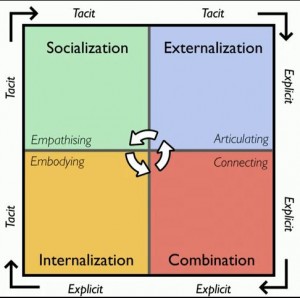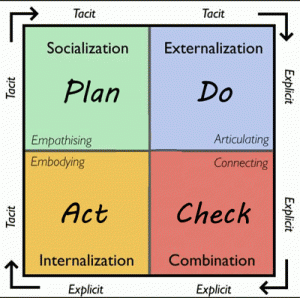Professor Ikujiro Nonaka in the book, The Knowledge-Creating Company: How Japanese Companies Create the Dynamics of Innovation proposed that organizational knowledge is created through a cycle of continuous social interaction of tacit and explicit knowledge involving four modes of knowledge conversion: Socialization, Externalization, Combination and Internalization. The cycle is a spiral one as each pass builds upon the other suggesting that each cycle builds on the previous one therefore accumulating knowledge. He depicts this in the SECI Model shown below.
 Explicit Knowledge can be captured in records of the past such as libraries, archives and databases and is assessed on a sequential basis. It can be expressed in words and numbers and shared in the form of data, scientific formulate, specifications, manuals and the like. This kind of knowledge can be readily transmitted between individuals formally and systematically.
Explicit Knowledge can be captured in records of the past such as libraries, archives and databases and is assessed on a sequential basis. It can be expressed in words and numbers and shared in the form of data, scientific formulate, specifications, manuals and the like. This kind of knowledge can be readily transmitted between individuals formally and systematically.
Tacit Knowledge is highly personal and hard to formalize, making it difficult to communicate of share with others. Subjective insights, intuitions and hunches fall into this category of knowledge. It is deeply rooted in and individuals’ actions and experience as well as in the ideals, values, or emotions.
Socialization: This mode enables the conversion of tacit knowledge through interaction between individuals. The key to acquiring tacit knowledge is experience. Without some form of shared experience, it will be extremely difficult for people to share each others thinking process. The tacit knowledge is exchanged through joint activities rather than through written or verbal instructions. In practice, socialization involves capturing knowledge through physical proximity. The process of acquiring knowledge is largely supported through direct interaction with people.
Internalization is the conversion of explicit knowledge into the organization’s tacit knowledge. This requires the individual to identify the knowledge relevant for one’s self within the organizational knowledge. That again requires finding one’s self in a larger entity. Learning by doing, training and exercises allow the individual to access the knowledge realm of the group and the entire organization. In practice, internalization relies on two dimensions:
- Explicit knowledge has to be embodied in action and practice. Thus, the process of internalizing explicit knowledge actualizes concepts or methods about strategy, tactics, innovation or improvement. For example, training programs in larger organizations help the trainees to understand the organization and themselves in the whole.
- Embodying the explicit knowledge by using simulations or experiments to trigger learning by doing processes. New concepts or methods can thus be learned in virtual situation
Combination involves the conversion of explicit knowledge into more complex sets of explicit knowledge. In the combination process,justification (the basis for agreement) takes place and allows the organization to take practical concrete steps.
In practice, the combination phase relies on three processes.
- Collecting externalized knowledge from inside or outside the company and the combining such data.
- Transferring this form of knowledge directly by using presentations or meeting.
- Editing or processing of explicit knowledge makes it more usable (e.g. documents such as plans, report, market data).
Knowledge conversion involves the process of social processes to combine different bodies of explicit knowledge held by individuals. The reconfiguring of existing information through the sorting, adding, re-categorizing and re-contextualizing of explicit knowledge can lead to new knowledge. This process of creating explicit knowledge from explicit knowledge is referred to as combination.
Externalization requires the expression of tacit knowledge and its translation into comprehensible forms that can be understood by others. In philosophical terms, the individual transcends the inner and outer boundaries of the self. During the externalization stage individual commits to the group and thus becomes one with the group. The sum of the individuals’ intentions and ideas fuse and become integrated with the group’s mental world. In practice, externalization is supported by two key factors.
- Articulation of tacit knowledge—that is, the conversion of tacit into explicit knowledge –involves techniques that help to express one’s ideas’ or images as words, concepts, figurative language (such as metaphors, analogies or narratives) and visuals. Dialogues, “listening and contributing to the benefit of all participants,” strongly support externalization.
- Translating the tacit knowledge of people into readily understandable forms. This may require deductive/inductive reasoning or creative inference (abduction).
The information above is paraphrased from the Cyberart Database and from Professor Nanaka’s book, The Knowledge-Creating Company: How Japanese Companies Create the Dynamics of Innovation. 
When you consider continuous improvement for Sales and Marketing many people relate PDCA to the typical manufacturing analogies such as cycle time and waste reduction. The SECI Model, I have found to be useful in transferring the knowledge-creation activities or thoughts to PDCA. Overlaying the PDCA cycle on the SECI Model correlates to what must occur when viewing PDCA as a knowledge creating methodology. I think it adds a much better focus on the problem solving cycle and how it relates to the transfer of knowledge needed. It further defines the types of human interactions required during each part of the cycle.
The importance of this characterization is to move away from the old model of seeing value from a perspective of goods and services to the new model where value is created or even co-created from experiences. We can no longer market to the memory of our customer but must market and become part of their activities.
The framework of the SECI Model is one of a continuous growing spiral increasing in knowledge. When applied to Marketing with PDCA, it can be viewed as a funnel creating a stronger and stronger transfer of knowledge between the customer and supplier. This knowledge is not only about benefits and features but values and beliefs. It is an increasing spiral of compatibility.
Related Posts:
Lean Marketing Creates Knowledge for the Customer
Why Lean Marketing? Because it is the Future of Marketing …
The Pull in Lean Marketing
The 7 step Lean Process of Marketing to Toyota
The Marketing Knowledge Spiral

Comments are closed.